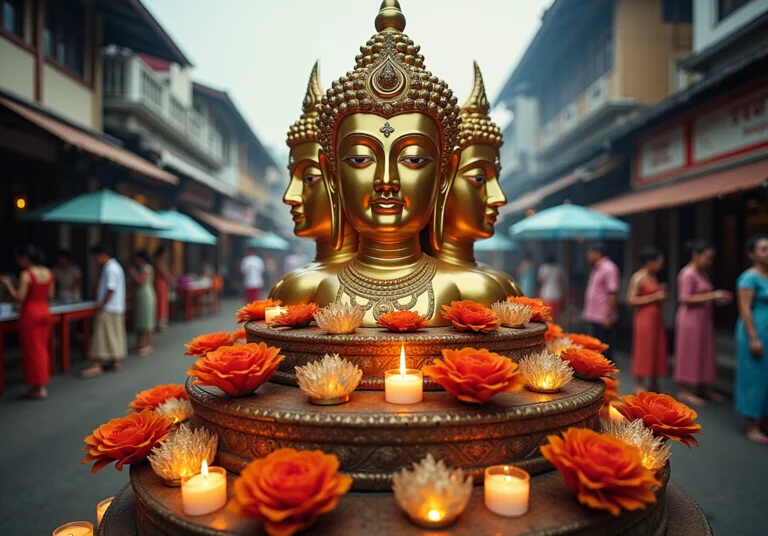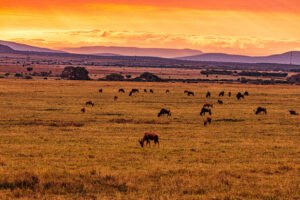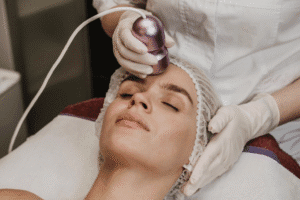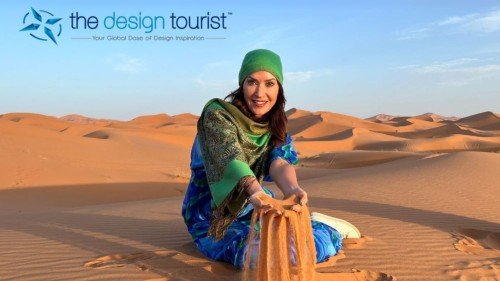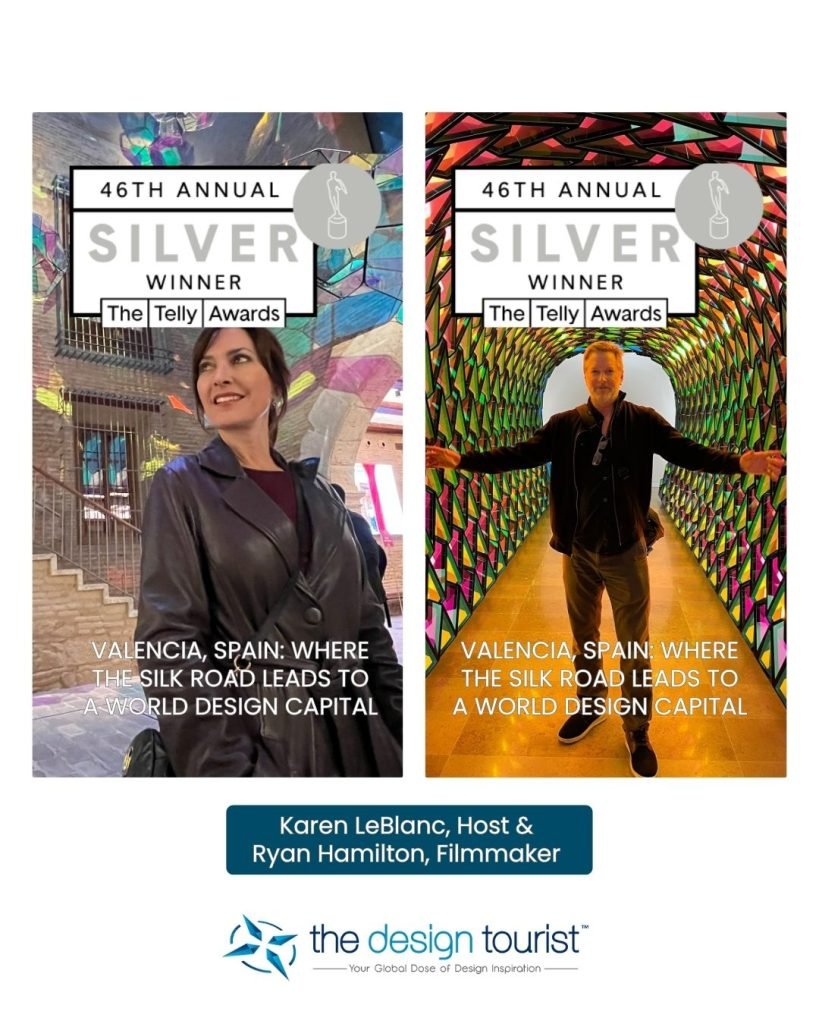Overview
Have you ever heard of the Four-Faced Buddha, or Phra Phrom? This fascinating figure symbolizes different aspects of life—career, love, health, and wealth—through its four distinct faces, which represent the Hindu god Brahma. It’s a beautiful blend of cultures that you can really feel when you visit!
The Erawan Shrine, established in 1956, is a must-visit site where these spiritual beliefs come alive through vibrant rituals and offerings. It showcases how Hinduism and Buddhism harmoniously coexist in Thai culture. You’ll find that the energy here is simply captivating!
So, if you’re planning a trip, make sure to include a stop at this cultural gem. It’s an experience that truly enriches your understanding of the local traditions and beliefs. Trust me, you won’t regret it!
Key Highlights:
- Phra Phrom, or the Four-Faced Buddha, represents Brahma, the Hindu god of creation, with each face symbolising different aspects of life.
- The front face is associated with career, the right with love, the back with health, and the left with wealth.
- The Erawan Shrine, built in 1956, serves as a significant site for worship and blends Hindu and Buddhist beliefs.
- The shrine was originally constructed to appease spirits causing misfortune during a nearby hotel construction.
- Rituals at the shrine include clockwise offerings, bowing three times before each face, and hiring traditional dancers for prayers.
- Visitors to the Erawan Shrine can experience a vibrant atmosphere and participate in cultural practises, enhancing their spiritual connexion.
Introduction
Have you ever heard of the Four-Faced Buddha, or Phra Phrom as it’s known in Thailand? This captivating figure is more than just a statue; it’s a beautiful blend of spirituality and cultural fusion, showcasing the intricate relationship between Hinduism and Buddhism. Each of the deity’s four faces represents a unique aspect of life—career, love, health, and wealth—offering you a holistic approach to seeking blessings. But what’s the story behind this revered figure?
Exploring the Four-Faced Buddha reveals its fascinating historical roots and significance within Thai culture. Plus, the vibrant rituals and practices that thrive at the Erawan Shrine invite both locals and travelers to immerse themselves in a rich tapestry of devotion and tradition. It’s an experience that promises to be both enlightening and memorable!
Define the Four-Faced Buddha: Origins and Symbolism
Have you ever heard of the four face buddha? Known as Phra Phrom in Thai, this fascinating figure represents Brahma, the Hindu god of creation. What’s unique about Phra Phrom is that he is a four face buddha, with each of his faces representing a different cardinal direction, symbolizing his omnipresence and all-seeing nature. Each face is tied to different aspects of life:
- The front face focuses on career and life.
- The right face symbolizes love and relationships.
- The back face signifies health.
- The left face embodies wealth.
Isn’t it amazing how this multifaceted representation of the four face buddha highlights the deity’s role in offering blessings across various areas of our lives?
The Erawan Shrine, where you can find Phra Phrom, was built and blessed in 1956. It beautifully reflects a blend of Hindu and Buddhist beliefs that resonate deeply within the local spiritual landscape. Located at the bustling Ratchaprasong intersection, the shrine is super accessible! When you visit, you’ll find a vibrant atmosphere where you can purchase offerings like flowers, incense sticks, and candles to enhance your worship experience. It’s a wonderful way to connect with the culture and spirituality of Thailand!
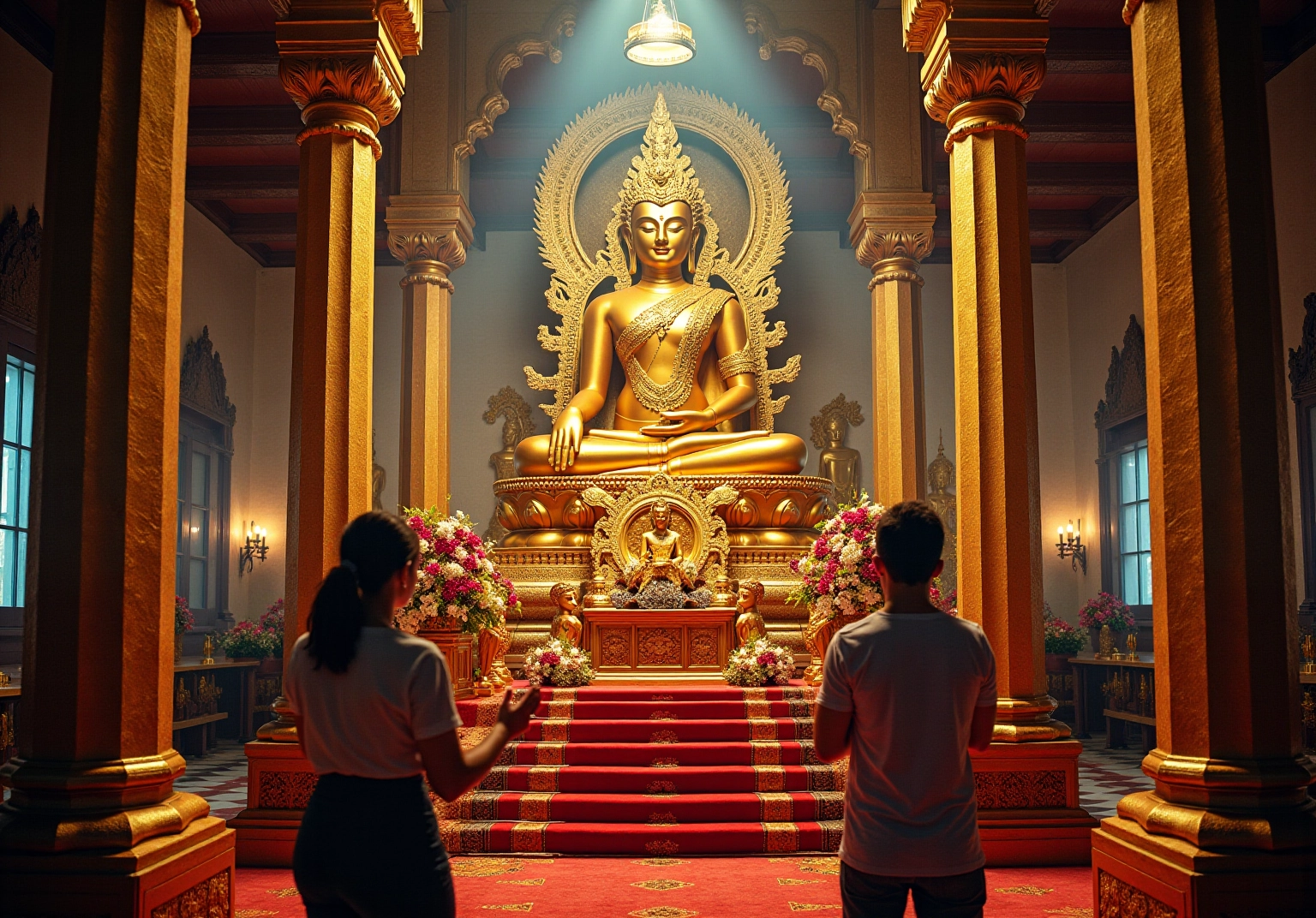
Explore the Historical Context of the Four-Faced Buddha in Thai Culture
Have you ever heard of the Four-Sided Deity? It has such deep roots in the vibrant culture of Thailand, all thanks to the influence of Hinduism that found its way here centuries ago. One of the must-visit spots is the Erawan Shrine in Bangkok, where the four face Buddha is venerated as a fascinating deity. It’s more than just a shrine; it’s a cultural landmark that tells a story!
Originally built in 1956, the shrine was created to appease the spirits believed to be causing misfortunes during the hotel construction nearby. Can you imagine the energy and hope that surrounded its creation? Over time, it has blossomed into a major pilgrimage site, drawing in both locals and tourists alike who come seeking blessings and guidance.
What’s truly captivating is how the integration of Brahma worship into Thai Buddhism, particularly the four face Buddha, reflects the beautiful syncretic nature of Thai spirituality. Here, elements of Hinduism and Buddhism coexist harmoniously, creating a rich tapestry of beliefs. It’s a perfect example of how cultures can blend and thrive together.
So, if you’re planning a trip to Bangkok, make sure to stop by the Erawan Shrine! You’ll not only witness the devotion of the people but also feel the vibrant spirit of a culture that embraces its diverse roots.
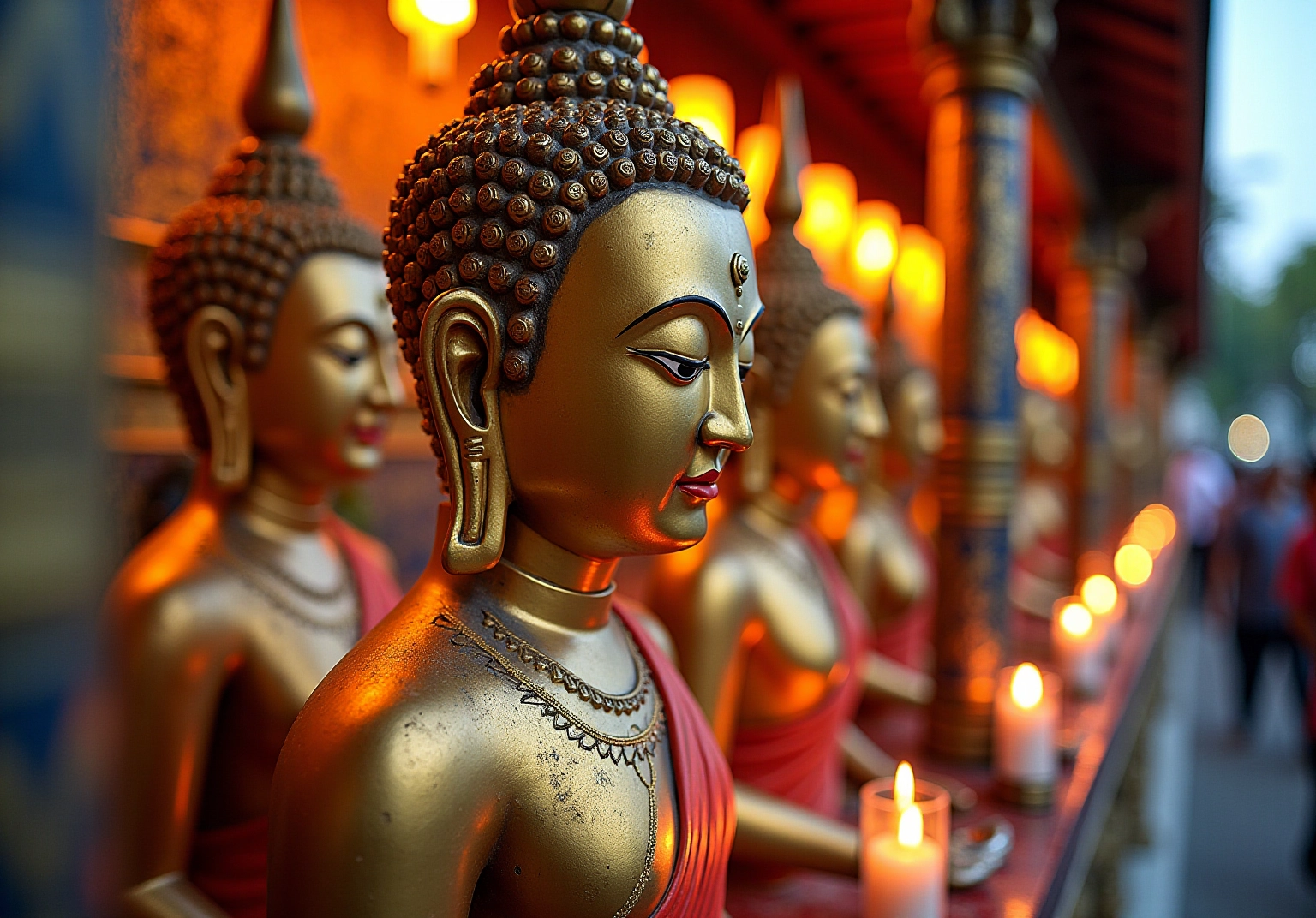
Detail the Rituals and Practices Surrounding the Four-Faced Buddha
When you step into the world of the four face buddha at the Erawan Shrine, you’re immersing yourself in a rich tapestry of tradition and spirituality! Devotees often approach the statue in a clockwise fashion, pausing at each of the four sides to offer heartfelt prayers and wishes. You’ll see common offerings like flowers, incense, and candles—these symbolize deep respect and devotion. Many worshippers even hire traditional Thai dancers, known as Khon performers, to grace the shrine with their art, believing these performances honor the deity and amplify their prayers.
A customary practice that you might find interesting is bowing three times before each face of the Buddha, a gesture that beautifully signifies reverence. The four face buddha is cherished for its association with specific blessings such as health, wealth, love, and career success! It’s no wonder so many people seek guidance from this revered figure in these essential areas of life.
Constructed in 1956, the Erawan Shrine boasts an open-air layout, nestled among cultural and commercial establishments. This creates a vibrant atmosphere that’s perfect for visitors like you! When you visit, remember to dress respectfully and be considerate of other worshippers when snapping photos. This delightful blend of ritual and belief, combined with the shrine’s rich history, draws in those looking for both spiritual fulfillment and a cultural connection. And if you’re wondering how to get there, the nearest BTS station is Chit Lom, making it super convenient for your exploration of this significant spiritual site!
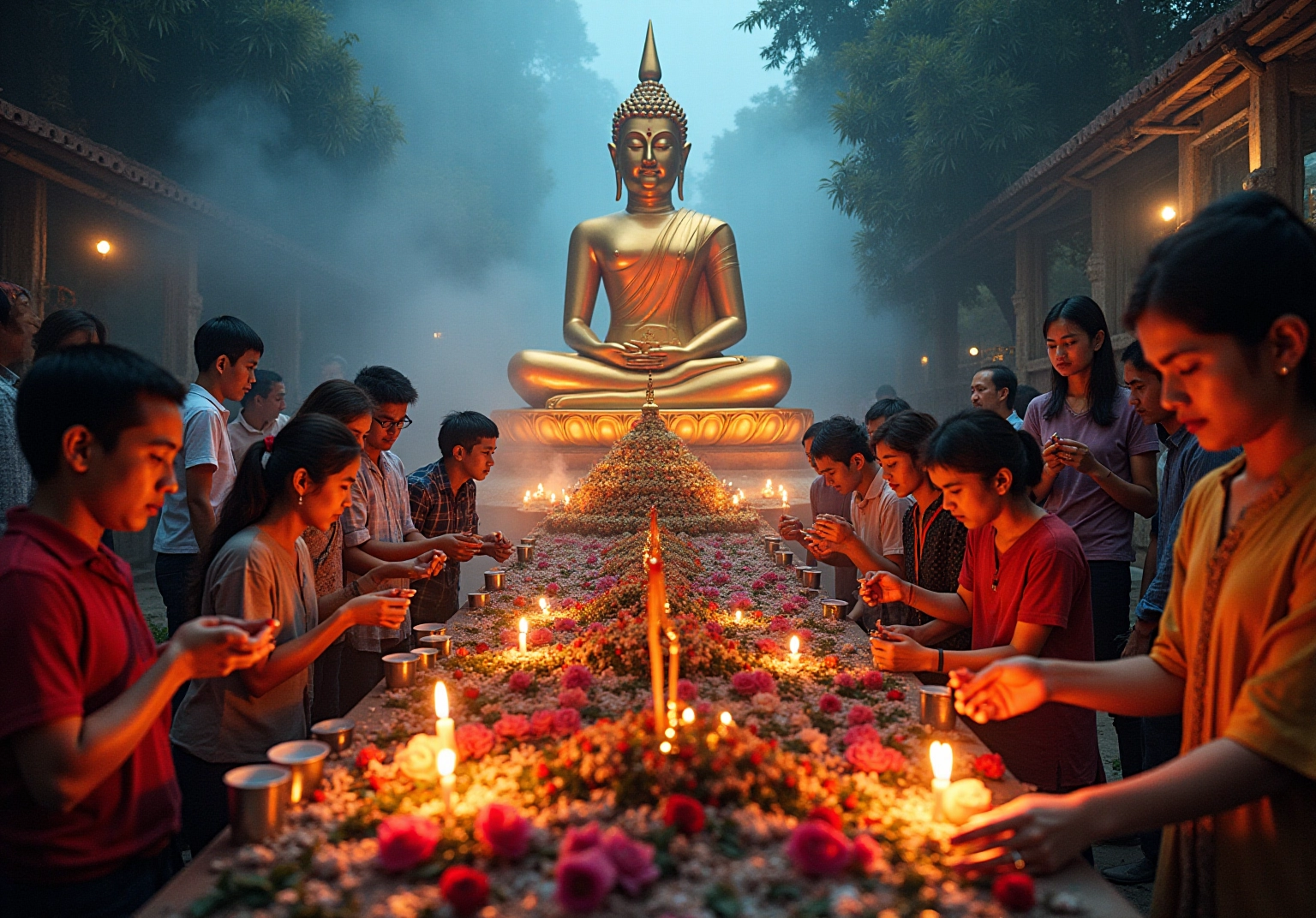
Conclusion
The Four-Faced Buddha, or Phra Phrom, is such a fascinating symbol of creation and blessings in so many aspects of life! It beautifully highlights how spirituality and culture intertwine in Thailand. Each of the Buddha’s four faces represents different dimensions of existence—career, love, health, and wealth—capturing the essence of omnipresence and the rich, multifaceted nature of our human experience.
As you dive into the history of the Erawan Shrine, where the Four-Faced Buddha is worshipped, you’ll uncover some intriguing insights. This shrine, built in 1956 to address construction misfortunes, has blossomed into a major pilgrimage site. It’s a wonderful example of how Hinduism and Buddhism harmoniously blend in Thai culture. The rituals surrounding the Four-Faced Buddha, including offerings and traditional performances, showcase the deep respect and devotion of worshippers seeking guidance in their lives.
Ultimately, the significance of the Four-Faced Buddha goes beyond its physical form; it embodies the vibrant tapestry of beliefs thriving in Thailand. Engaging with this cultural landmark allows you to connect with the region’s spiritual heritage while participating in a living tradition that celebrates a unity of diverse influences. By embracing the teachings and rituals associated with the Four-Faced Buddha, you’ll gain a deeper appreciation for the cultural and spiritual landscapes that shape our world. So, why not plan a visit and experience this incredible journey for yourself?
Frequently Asked Questions
Who is the Four-Faced Buddha?
The Four-Faced Buddha, known as Phra Phrom in Thai, represents Brahma, the Hindu god of creation.
What does each face of the Four-Faced Buddha symbolize?
Each face of the Four-Faced Buddha symbolizes different aspects of life: the front face focuses on career and life, the right face symbolizes love and relationships, the back face signifies health, and the left face embodies wealth.
Where can the Four-Faced Buddha be found?
The Four-Faced Buddha can be found at the Erawan Shrine, which is located at the Ratchaprasong intersection in Thailand.
When was the Erawan Shrine built and blessed?
The Erawan Shrine was built and blessed in 1956.
What is the significance of the Erawan Shrine?
The Erawan Shrine reflects a blend of Hindu and Buddhist beliefs and resonates deeply within the local spiritual landscape.
What can visitors do at the Erawan Shrine?
Visitors to the Erawan Shrine can purchase offerings such as flowers, incense sticks, and candles to enhance their worship experience.








